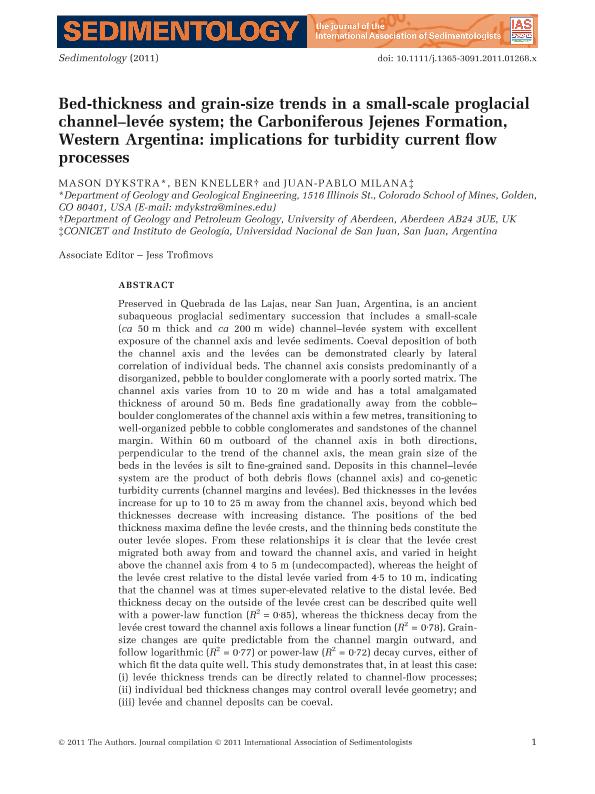Mostrar el registro sencillo del ítem
dc.contributor.author
Dykstra, Mason
dc.contributor.author
Kneller, Ben
dc.contributor.author
Milana, Juan Pablo

dc.date.available
2023-02-27T10:37:32Z
dc.date.issued
2011-07
dc.identifier.citation
Dykstra, Mason; Kneller, Ben; Milana, Juan Pablo; Bed-thickness and grain-size trends in a small-scale proglacial channel-levée system; the Carboniferous Jejenes Formation, Western Argentina: Implications for turbidity current flow processes; Wiley Blackwell Publishing, Inc; Sedimentology; 59; 2; 7-2011; 605-622
dc.identifier.issn
0037-0746
dc.identifier.uri
http://hdl.handle.net/11336/188887
dc.description.abstract
Preserved in Quebrada de las Lajas, near San Juan, Argentina, is an ancient subaqueous proglacial sedimentary succession that includes a small-scale (ca 50 m thick and ca 200 m wide) channel–levee system with excellent exposure of the channel axis and levee sediments. Coeval deposition of both the channel axis and the levees can be demonstrated clearly by lateral correlation of individual beds. The channel axis consists predominantly of a disorganized, pebble to boulder conglomerate with a poorly sorted matrix. The channel axis varies from 10 to 20 m wide and has a total amalgamated thickness of around 50 m. Beds fine gradationally away from the cobble–boulder conglomerates of the channel axis within a few metres, transitioning to well-organized pebble to cobble conglomerates and sandstones of the channel margin. Within 60 m outboard of the channel axis in both directions, perpendicular to the trend of the channel axis, the mean grain size of the beds in the levees is silt to fine-grained sand. Deposits in this channel–levee system are the product of both debris flows (channel axis) and co-genetic turbidity currents (channel margins and levees). Bed thicknesses in the levees increase for up to 10 to 25 m away from the channel axis, beyond which bed thicknesses decrease with increasing distance. The positions of the bed thickness maxima define the levee crests, and the thinning beds constitute the outer levee slopes. From these relationships it is clear that the levee crest migrated both away from and toward the channel axis, and varied in height above the channel axis from 4 to 5 m (undecompacted), whereas the height of the levee crest relative to the distal levee varied from 4.5 to 10 m, indicating that the channel was at times super-elevated relative to the distal levee. Bed thickness decay on the outside of the levee crest can be described quite well with a power-law function (R2=0.85), whereas the thickness decay from the levee crest toward the channel axis follows a linear function (R2 =0.78). Grain-size changes are quite predictable from the channel margin outward, and follow logarithmic (R2=0.77) or power-law (R2=0.72) decay curves, either of which fit the data quite well. This study demonstrates that, in at least this case: (i) levee thickness trends can be directly related to channel-flow processes; (ii) individual bed thickness changes may control overall levee geometry; and (iii) levee and channel deposits can be coeval.
dc.format
application/pdf
dc.language.iso
eng
dc.publisher
Wiley Blackwell Publishing, Inc

dc.rights
info:eu-repo/semantics/openAccess
dc.rights.uri
https://creativecommons.org/licenses/by-nc-sa/2.5/ar/
dc.subject
BED THICKNESS DECAY
dc.subject
CARBONIFEROUS
dc.subject
CHANNEL
dc.subject
CHANNEL-LEVÉE
dc.subject
DEBRIS-FLOW
dc.subject
DEGLACIAL
dc.subject
PRO-GLACIAL
dc.subject
TURBIDITY CURRENT
dc.subject.classification
Otras Ciencias de la Tierra y relacionadas con el Medio Ambiente

dc.subject.classification
Ciencias de la Tierra y relacionadas con el Medio Ambiente

dc.subject.classification
CIENCIAS NATURALES Y EXACTAS

dc.title
Bed-thickness and grain-size trends in a small-scale proglacial channel-levée system; the Carboniferous Jejenes Formation, Western Argentina: Implications for turbidity current flow processes
dc.type
info:eu-repo/semantics/article
dc.type
info:ar-repo/semantics/artículo
dc.type
info:eu-repo/semantics/publishedVersion
dc.date.updated
2023-02-21T22:18:02Z
dc.journal.volume
59
dc.journal.number
2
dc.journal.pagination
605-622
dc.journal.pais
Reino Unido

dc.journal.ciudad
Londres
dc.description.fil
Fil: Dykstra, Mason. Colorado School of Mines; Estados Unidos
dc.description.fil
Fil: Kneller, Ben. University of Aberdeen; Reino Unido
dc.description.fil
Fil: Milana, Juan Pablo. Universidad Nacional de San Juan. Facultad de Ciencias Exactas, Físicas y Naturales. Instituto de Geología "Dr. Emiliano Aparicio"; Argentina. Consejo Nacional de Investigaciones Científicas y Técnicas. Centro Científico Tecnológico Conicet - San Juan; Argentina
dc.journal.title
Sedimentology

dc.relation.alternativeid
info:eu-repo/semantics/altIdentifier/doi/http://dx.doi.org/ 10.1111/j.1365-3091.2011.01268.x
dc.relation.alternativeid
info:eu-repo/semantics/altIdentifier/url/https://onlinelibrary.wiley.com/doi/abs/10.1111/j.1365-3091.2011.01268.x
Archivos asociados
